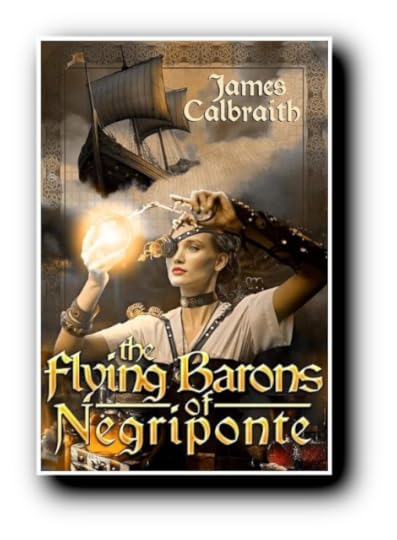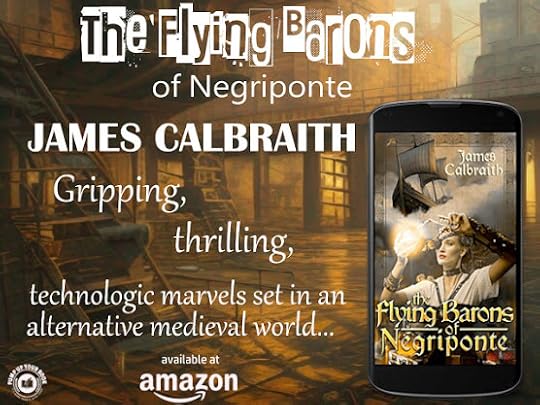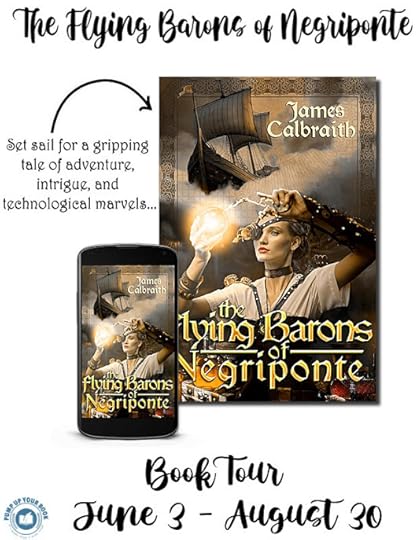How Punk is Your Candle? by James Calbraith

In the ruins of a fallen Empire, the first ever female pilot takes part in a flying boat race to free her people from the foreign oppression…
 Title: The Flying Barons of Negriponte (The Aether Empire Book 1)Author: James Calbraith
Title: The Flying Barons of Negriponte (The Aether Empire Book 1)Author: James CalbraithPublication Date: September 20, 2023
Pages: 134Genre: Historical Fantasy/CandlepunkThey killed her father. They took her ship. But nothing will stop Ikaria's vengeance.Forty years since Constantinople fell to the Venetian flying citadels, high-altitude Aether racing is the favoured pastime of bored, wealthy Latin nobles. Ikaria, proud daughter of a legendary Aether engineer and one of the best racing pilots in the Aegean, is determined to uncover the truth behind her father's mysterious disappearance at the end of the last Grande Regatta of Negriponte.
Driven by the thirst of vengeance and pursuit of engineering excellence in equal measures, Ikaria vows to win the next Regatta herself - and to find out what really happened to her father. But there's a catch: a new Imperial edict bars her, and anyone not of noble blood, from taking part in Aether races. To her rescue comes Sire Mikhael of Chiarenza - an enigmatic handsome young Greek turncoat in the service of new Latin masters. His motivations unclear, the source of his funds and supplies a secret, Ikaria nonetheless agrees to accept his help: together, they set out to challenge the supremacy of the six Hexarchs, the infamous Flying Barons of Negriponte.
Pick up your copy of The Flying Barons of Negriponte at https://www.amazon.com/dp/B0CJKXXQB1 .

Book Excerpt:
 A black-headed gull landed on the bowsprit. It glanced around, confused as to why a small, sleek sailboat suddenly appeared in its path in the middle of a billowing cloud hundreds of feet above the surface of the sea. Its eyes met Ikaria’s; the bird squawked in indignation and spread its wings as if to protest this sin against God and nature. A sudden, violent gust pushed it off the spar. Still squawking in disgust, the gull continued on its way while the boat pushed onwards, deeper into the cloud and out the other side.
A black-headed gull landed on the bowsprit. It glanced around, confused as to why a small, sleek sailboat suddenly appeared in its path in the middle of a billowing cloud hundreds of feet above the surface of the sea. Its eyes met Ikaria’s; the bird squawked in indignation and spread its wings as if to protest this sin against God and nature. A sudden, violent gust pushed it off the spar. Still squawking in disgust, the gull continued on its way while the boat pushed onwards, deeper into the cloud and out the other side.A white-washed dot of Saint Elijah’s chapel appeared among the rocky outcrops, marking the eastern end of the Chalcis Pass. Ikaria reached under her tunic and took out a small brass key, inlaid with a piece of ruby glass, hung on a silver chain at her neck. Gingerly, she inserted it into a slot in the side of the Caput Chamber and turned it a quarter to the right. A conduit linking the Inhibitor Retort with the Tribikos Manifold hissed, indicating a forming air gap. She turned the spigot in the nozzle, releasing half a dram of the Inhibitor into the Sublimation Aludel. It took another few moments for the reaction to start. She turned to the Hygroscope and observed the four liquids behind the pane of rock crystal: a mixture of quicksilver, aqua fortis, brine and fish oil, each coloured with a different hue of vitriol, indicated the proportion of gaseous Quintessence – the Naviferous Aether – in the air under the hull. The liquids bubbled behind the crystal, reacting to a sudden change in pressure, then stabilised at the new levels, layer upon layer, at their respective measuring notches carved in the crystal pane. And then – a new layer emerged where there shouldn’t be one: a fifth, ruby-coloured liquid filled out the unmarked space between the quicksilver and aqua fortis.
– Excerpted from The Flying Barons of Negriponte by James Calbraith, Flying Squid, 2023. Reprinted with permission.
How Punkis your Candle?
From itsorigin, the term ‘steampunk’ was tongue-in-cheek. A play on ‘cyberpunk’invented only because cyberpunk was a popular genre at the time (early 1980s),it was always more about the ‘steam’ component – the aesthetics and fashions ofVictorian industrial era, the steam engines, the top hats, the airships, thepipes, valves and pulleys, the brass, leather and glass – than the actual‘punk’.
The‘punk’ of cyberpunk had a clear meaning: anarchy, evil corporations, dystopiancollapse, sex, drugs and rock’n’roll amid a cyber future. Not so muchsteampunk: moral dilemmas and philosophical musings often give way to simplylooking cool and having romping adventures in a steam-powered mechas or fighting gothic monsters in a moody mansion. The importance of aesthetics overstory could be the reason why steampunk, unlike cyberpunk, is betterrepresented in visual media – animation, graphic novels, video and tabletopgames – than literature.
That’snot to say there’s nothing important that steampunk can tell us as a genre. TheVictorian era was the time when our modern world was being forged; women foughtfor their rights, as did the working classes; slavery was finally abolished inthe West, but exploitative colonial empires thrived; the entire world becametruly interconnected for the first time, with steamers plying the oceans fromTokyo to San Francisco and from Cape Town to Vladivostok; revolutions wereslowly brewing that would soon bring the downfall of empires that had lastedfor centuries. These are all themes that a good steampunk story should, andwill, explore, in all its top-hatted, be-goggled glory.
And thenthere are all the other ‘-punks’. Like the Watergate building giving a part ofits name to all the political scandals since, so did Steampunk help to defineall the genres that emphasised retrofuturistic aesthetics. Clockpunk forRenaissance and Da Vinci-inspired mechanisms. Dieselpunk forthe 1940s era, with combustion engines replacing steam and black leathertrenchcoats instead of frocks. Decopunk for Art Deco. Atompunk forthe 1950s – think Fallout, Bioshock. For the age before Clockpunk, the HighMiddle Ages – in which my new book, “The Flying Barons of Negriponte” is set –no single good term has yet been invented. There’s Candlepunk, whichI prefer to use myself, but I’ve heard of Castlepunk, Monkpunk and evenDungeonpunk. Once again, all these terms focus on the aesthetics of thesetting: the source of power is alchemy and primitive clockwork; the fightingis done with swords, crossbows and, depending on the fictional century, earlygunpowder; the mood is dark, foggy and brooding, all hooded monks in candle-litrooms and armoured knights sinking in the bogs. But if you can’t find enough ofthe ‘punk’ element – dystopian social commentary – in the era of crusades,heresies, plagues, robber knights and peasant revolts, are you even trying?
About the Author

James Calbraith is a Poland-born Scottish writer of history-adjacent novels, coffee drinker, Steely Dan fan and avid traveller.
Growing up in communist Poland on a diet of powdered milk, “Lord of the Rings” and soviet science-fiction, he had his first story published at the ripe age of eight. After years of bouncing around Polish universities, he moved to London in 2007 and started writing in English. Now lives in Edinburgh, hoping for an independent Scotland.
His debut historical fantasy novel, “The Shadow of Black Wings“, has reached Amazon Breakthrough Novel Award semi-finals in 2012. “The Year of the Dragon” saga sold over 30,000 copies worldwide.
His new historical fiction saga, “The Song of Ash” has been on top of Amazon’s Bestseller lists in UK for months.
Connect with James:
Twitter | Facebook | Instagram | Goodreads | Bookbub | Wattpad | Quora




